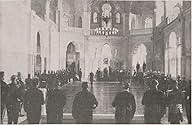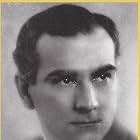Jalma La Double
YOUR RATING
Photos
Brindusa Grozavescu
- Jalma
- (as Groza Wesco)
Émile Mylo
- Malouk
- (as Emile Milo)
- Director
- Writers
- All cast & crew
- Production, box office & more at IMDbPro
Storyline
Featured review
In addition to producing cruelly abbreviated versions of films for the home-projectors the Pathé Kok and later the Pathé-Baby (known as Pathex or Pathescope in the US and Britain), Pathé also cut down films for distribution and projection in la France profonde using a 16mm projector known as the Pathé Rural.
This film I have only seen in what I take to be an extremely poor-quality Pathé Rural version, reduced to just 20 minutes (Pathé evidently took a dim view of the attention spans in the Auvergne or in the Aveyron) so it is almost impossible to judge its quality.
But it is a remarkable oddity. Based on a popular novel of 1907, it is set and filmed in Constantinople (Pathé gives the Turkish name of the city as Consantinople (Turks have trouble with "st") rather than Istanbul) where the sultan Murad V has been dethroned by his brother Abdul-Hamid on the pretext that he is mad and his daughter Jalma has been brought up in secret by a faithful subject, the peasant Ali, along with his own daughter, also called Jalma so that they themselves no longer know which girl is the princess and which the commoner. The sultan's henchman Yerba bey (played by the Russian actor Chakatouny) intends to marry the two girls off to foreigners (depriving whichever is the princess of her royal rights) and then imprison them but the two impoverished young French adventurers he chooses as their husbands have other ideas.... .
The film is also a defence of the supposedly benign French Protectorate which was steadily extending at this period to include more and more parts of the disintegrating Ottoman empire....
Apart from actors of Turkish/Armenian origin such as Hugues de Bagratide d'Arékine who plays Abdul-Hamid and the Romanian actress Groza Wesco (properly Brindusa Grozavescu) who plays the Princess Jalma, Mourad V is played by a certain Burhanneddin. Could this have been Mehmed Burhaneddin Efendi, one of the sons of the real Abdul-Hamid who was living at this time in France (he went to the United States in 1930) and spoke fluent French as well as English (and German)? According to a contemporary review the performance of De Bagratide as the former Emperor (not much in evidence in this cut-down version) was so realistic that the family (all exiles since the revolution of 1924) were uncomfortable with it and sought changes to the film. Certainly the portrayal of Abdul-Hamid is most unflattering. Perhaps Goupillière had one of their number in his cast as insurance.
Burhaneddin had been supposedly the favourite son of Abdul-Hamid but he was a highly cultured man unlike his father and may well have harboured sympathies for his wronged uncle Murad (28 years a prisoner)and come to regret some of the more brutal aspects of his father's rule. All he has to do in the film is look dignified and sad as the imprisoned Murad.
This film I have only seen in what I take to be an extremely poor-quality Pathé Rural version, reduced to just 20 minutes (Pathé evidently took a dim view of the attention spans in the Auvergne or in the Aveyron) so it is almost impossible to judge its quality.
But it is a remarkable oddity. Based on a popular novel of 1907, it is set and filmed in Constantinople (Pathé gives the Turkish name of the city as Consantinople (Turks have trouble with "st") rather than Istanbul) where the sultan Murad V has been dethroned by his brother Abdul-Hamid on the pretext that he is mad and his daughter Jalma has been brought up in secret by a faithful subject, the peasant Ali, along with his own daughter, also called Jalma so that they themselves no longer know which girl is the princess and which the commoner. The sultan's henchman Yerba bey (played by the Russian actor Chakatouny) intends to marry the two girls off to foreigners (depriving whichever is the princess of her royal rights) and then imprison them but the two impoverished young French adventurers he chooses as their husbands have other ideas.... .
The film is also a defence of the supposedly benign French Protectorate which was steadily extending at this period to include more and more parts of the disintegrating Ottoman empire....
Apart from actors of Turkish/Armenian origin such as Hugues de Bagratide d'Arékine who plays Abdul-Hamid and the Romanian actress Groza Wesco (properly Brindusa Grozavescu) who plays the Princess Jalma, Mourad V is played by a certain Burhanneddin. Could this have been Mehmed Burhaneddin Efendi, one of the sons of the real Abdul-Hamid who was living at this time in France (he went to the United States in 1930) and spoke fluent French as well as English (and German)? According to a contemporary review the performance of De Bagratide as the former Emperor (not much in evidence in this cut-down version) was so realistic that the family (all exiles since the revolution of 1924) were uncomfortable with it and sought changes to the film. Certainly the portrayal of Abdul-Hamid is most unflattering. Perhaps Goupillière had one of their number in his cast as insurance.
Burhaneddin had been supposedly the favourite son of Abdul-Hamid but he was a highly cultured man unlike his father and may well have harboured sympathies for his wronged uncle Murad (28 years a prisoner)and come to regret some of the more brutal aspects of his father's rule. All he has to do in the film is look dignified and sad as the imprisoned Murad.
Details
- Release date
- Country of origin
- Language
- Also known as
- In Old Stamboul
- Production company
- See more company credits at IMDbPro
- Color
- Sound mix
- Aspect ratio
- 1.33 : 1
Contribute to this page
Suggest an edit or add missing content


